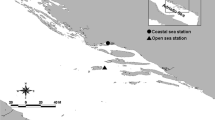Abstract
A variety of approaches including enumeration of visibly infected microbes, removal of viral particles, decay of viral infectivity, and measurements of viral production rates have been used to infer the impact of viruses on microbial mortality. The results are surprisingly consistent and suggest that, on average, about 20% of marine heterotrophic bacteria are infected by viruses and 10–20% of the bacterial community is lysed daily by viruses. The effect of viruses on phytoplankton is less certain, but ca. 3% of Synechococcus biomass may be lysed daily. The fraction of primary productivity this represents depends upon the relative biomass and growth rate of Synechococcus. Virus enrichment experiments suggest that the productivity of eukaryotic phytoplankton would be ca. 2% higher in the absence of viruses. Overall, probably about 2–3% of primary productivity is lost to viral lysis. There is considerable variation about these estimates; however, they represent a starting point for incorporating viral-mediated processes into aquatic ecosystem models.
Similar content being viewed by others
References
Berry SA, Noton BG (1976) Survival of bacteriophages in seawater. Water Res 10:323–327
Bitton G, Mitchell R (1974) Effect of colloids on the survival of bacteriophages in seawater. Water Res 8:227–229
Bratkbak G, Heldal M, Thingstad TF, Riemann B, Haslund OH (1992) Incorporation of viruses into the budget of microbial C-transfer. Mar Ecol Prog Ser 83:273–280
Cottrell MT, Suttle CA (1991) Wide-spread occurrence and clonal variation in viruses which cause lysis of a cosmopolitan, eukaryotic marine phytoplankter, Micromonas pusilla. Mar Ecol Prog Ser 78:1–9
Fuhrman JA, Suttle CA (1993) Viruses in marine planktonic systems. Oceanography 6:50–62
Gerba CP, Schaiberger GE (1975) Effects of particulates on virus survival in seawater. J Water Pollut Control Fed 47:93–103
Heldal M, Bratbak G (1991) Production and decay of viruses in aquatic environments. Mar Ecol Prog Ser 72:205–212
Moebus K (1992) Laboratory investigations on the survival of marine bacteriophages in raw and treated seawater. Helgoländer Meeresunters 46:251–273
Murray AG, Jackson GA (1992) Viral dynamics: a model of the effects of size, shape, motion, and abundance of single-celled planktonic organisms and other particles. Mar Ecol Prog Ser 89:103–116
Proctor LM, Fuhrman JA (1990) Viral mortality of marine bacteria and cyanobacteria. Nature (Lond) 343:60–62
Proctor LM, Okubo A, Fuhrman JA (1993) Calibrating estimates of phage-induced mortality in marine bacteria: ultrastructural studies of marine bacteriophage development from one-step growth experiments. Microb Ecol 25:161–182
Steward GF, Wikner J, Smith DC, Cochlan WP, Azam F (1993) Measurement of virus production in the sea: I. Method development. Mar Microb Foodwebs 6:57–78
Steward GF, Wikner J, Cochlan WP, Smith DC, Azam F (1993) Measurement of virus production in the sea. II. Field results. Mar Microb Foodwebs 6:79–90
Suttle CA (1992) Inhibition of photosynthesis in phytoplankton by the submicron size fraction concentrated from seawater. Mar Ecol Prog Ser 87:105–112
Suttle CA, Chan AM (1993) Marine cyanophages infecting oceanic and coastal strains of Synechococcus: abundance, morphology, cross-infectivity and growth characteristics. Mar Ecol Prog Ser 92:99–109
Suttle, CA, Chen F (1992) Mechanisms and rates of decay of marine viruses in seawater. Appl Environ Microbiol 58:3721–3729
Suttle CA, Chan AM, Cottrell MT (1990) Infection of phytoplankton by viruses and reduction of primary productivity. Nature (Lond) 347:467–469
Waterbury JB, Valois FW (1993) Resistance to cooccurring phages enables marine Synechococcus communities to coexist with cyanophages abundant in seawater. Appl Environ Microbiol 59:3393–3399
Zachary A (1976) Physiology and ecology of bacteriophages of the marine bacterium Beneckea natriegens: salinity. Appl Environ Microbiol 31:415–422
Author information
Authors and Affiliations
Rights and permissions
About this article
Cite this article
Suttle, C.A. The significance of viruses to mortality in aquatic microbial communities. Microb Ecol 28, 237–243 (1994). https://doi.org/10.1007/BF00166813
Issue Date:
DOI: https://doi.org/10.1007/BF00166813



